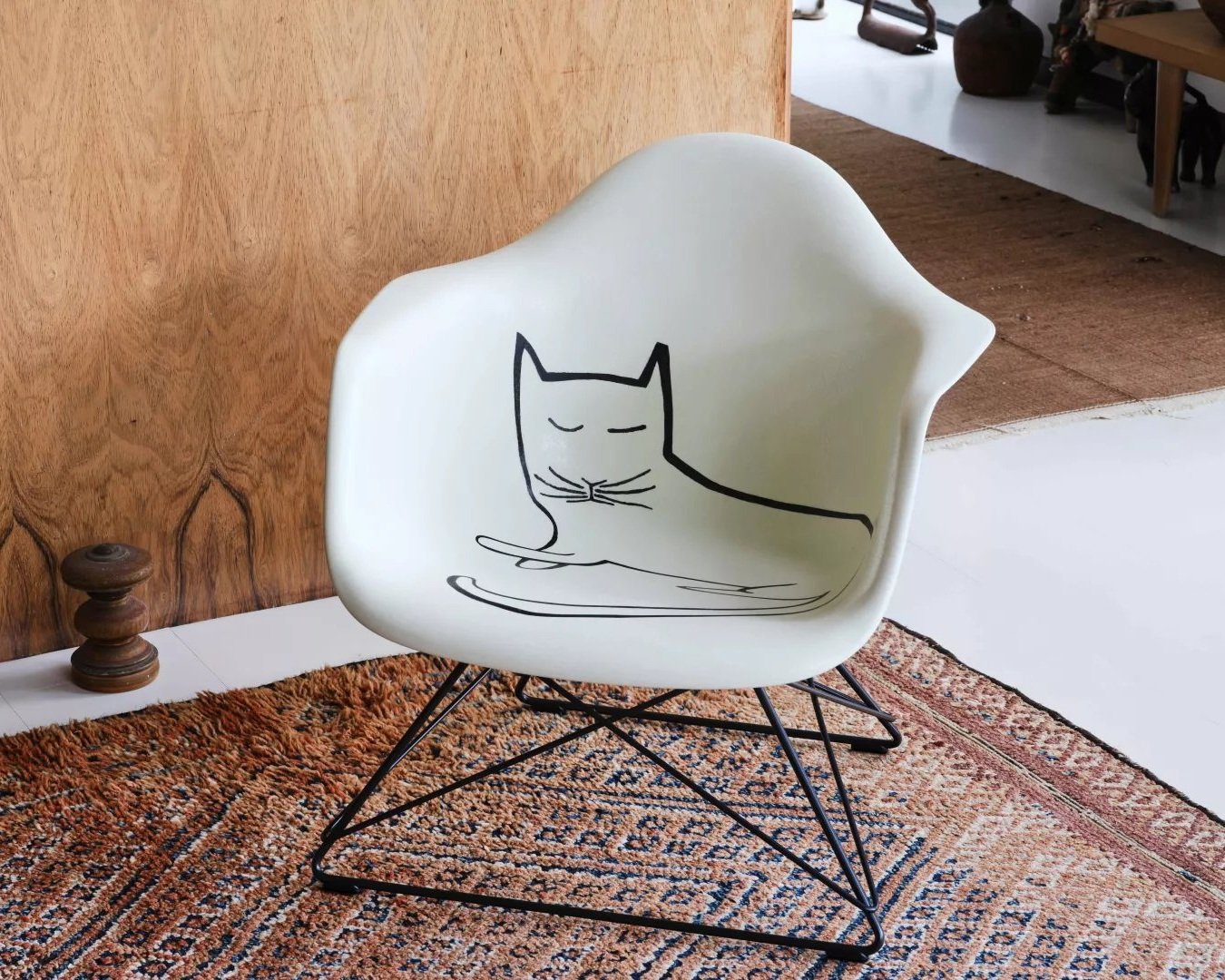Design Line: 27 May – 2 June
This week’s Design Line has had some difficult news to digest: a chatbot who has been giving out dangerous advice, political ugliness in Venice, and spying smart doorbells. So thank god we’ve also had some comfort to see us through: treating ourselves to a new paper-wrapped Mars bar, and sinking down into a reassuring, cat-decorated chair.
Protect the chocolate
The pandemic has left us all with a case of treat brain. How can we get through the day without a tasty little snack? But buying individual chocolate bars takes a terrible toll on the environment, with all those non-recyclable plastic wrappers thrown straight into the bin. Design-wise, a disposable plastic wrapper is ideal for food-safe transport and distribution, but as pressure from consumers for more environmentally sound options mounts, confectionary brands are starting to take notice. Mars Incorporated, maker of the eponymous Mars bar, is trialling paper packaging for its nougat-y and caramel spiked chocolate snack. “The challenge was to find the right paper packaging solution with an adequate level of barrier properties to protect the chocolate,” said Richard Sutherland-Moore, a packaging expert at Mars Wrigley UK’s research and development centre. The pilot scheme, which includes a bright green logo on the packets to encourage snackers to recycle responsibly, will launch at 500 Tesco stores. Rival choc purveyor Nestlé has already binned individual cellophane wrappers for its Quality Street tins in favour of recyclable options, and switched out KitKat packaging for an 80 per cent recycled plastic version. Of course, the ultimate in eco-friendly sweet snacks is a fruit option (the biodegradable wrappers are built in) but if you need a chocolate fix then the packaging designers are working to have you covered.
A foreseeable fiasco
Who could have predicted that firing trained helpline staff after they unionised and replacing them with a chatbot would end badly? Well, everyone except for the executives of the National Eating Disorder Association (NEDA) in the US. When four NEDA helpline staffers unionised in May to lobby for higher staffing, NEDA bosses responded by firing them all and replacing them with a chatbot named Tessa. Tessa’s creators, Ellen Fitzsimmons-Craft and her team at Washington University’s medical school, told Motherboard that the chatbot was “designed to teach people evidence-based strategies to prevent and provide some early intervention for eating disorder symptoms.” However, within days NEDA has had to take Tessa offline after she was found to be advising helpline callers to lose weight and calorie count. Throwing more fuel on this PR fire, NEDA’s communications and marketing vice president Sarah Chase accused the person who drew attention to the issue of lying on their Instagram post about the problem, before hastily deleting the comment. While app-based mental health services have been growing in popularity, AI designed to interact with vulnerable people in distress – without another human’s supervision – is proving to be a recklessly risky industry. Earlier this year the founders of a mental health support app called Koko admitted that it had used Chat-GPT3 to respond to users, without gaining informed consent for the experiment. Activists have highlighted that the psychiatry lab that created Tessa also works to “prevent and treat obesity”, suggesting that very human biases for encouraging weight loss snuck into an algorithm designed to help people whose illness would be triggered by that same activity. Seemingly unrepentant, NEDA has vowed to debug Tessa and get her up and advising eating disorder sufferers again.
Killing Architects’ Investigating Xinjiang’s Network of Detention Camps by Killing Architects – the installation purported to have put China to flight from Venice (image: Marco Zorzanello, courtesy of La Biennale di Venezia).
Killing in Venice
More controversy at the 2023 Venice Architecture Biennale this week, as rumours swirl that China withdrew from the event following the inclusion of Alison Killing’s investigation into allegations of Chinese internment camps. Killing, a British architect, won a Pulitzer Prize along with Megha Ragagopalan and Christo Buschek for their work using architectural tools and satellite imagery to investigate government camps suspected of detaining Uyghurs in Xinjiang. Killing is exhibiting the findings of the investigation, including a 30-minute film on the tools and techniques applied, at the biennale’s main exhibition curated by Leslie Lokko. The Chinese Embassy in Italy made a statement alleging “the relevant reports seriously deviate from the facts and the so-called 'evidence' is based on a large amount of false information” and accusing the Italian media of having “taken advantage of some Chinese events to speculate again on the issues relating to Xinjiang.” Speaking to Dezeen, Killing defended the installation: "We stand by our reporting. All the information in both the original articles and in the subsequent exhibition were corroborated in multiple ways.” Italian news outlet Decode 39 reported that China has dropped out of the exhibition and cancelled an ambassadorial dinner in response. Buzzfeed News, the platform where Killing published the Pulitzer-winning story, was closed by Buzzfeed last month and all its reporters laid off as the company announced it is “leaning into” AI.
All furniture can be improved through the addition of a cat (image: Florian Böhm, courtesy of Vitra).
Put a cat on it!
In the early 2010s, sketch comedy show Portlandia coined the term “Put a bird on it!”, spoofing hipster culture through a skit about a couple’s desire to liven up “sad, little” products through the liberal addition of bird decals. We bring this up for no reason. Also this week, Disegno began thinking ahead to the planned 14 June launch of Vitra and Herman Miller’s new edition of 500 Eames Fiberglass Armchairs, all of which have been emblazoned with a painting of a cat done by the artist 20th-century artist Saul Steinberg (who originally rendered a version of said cat on one of the chairs in Charles and Ray Eames’s studio when he went to visit them). Superfluous, silly and something of a cash grab, undoubtedly, but the cat is also very, very cute, so consider Disegno fully on board with the entire operation. More broadly, the edition appears to further feed into Vitra’s recent explorations of the drop model of retail being deployed within furniture design. Straight out of sneaker culture, a drop seems an odd fit for furniture that is typically billed as being timeless and trend-resistant. Nevertheless, Vitra seems to have found success with the format – its use of drops for the work of Jean Prouvé has resulted in sellouts – so perhaps there is mileage in its use within the field yet. An interesting reflection on the way design is sold combined with the far more important business of a cute, sleepy cat. What’s not to like?
A handsome space, devoted to making damaged things handsome once more (image: Loewe).
ReCraft retail
Spanish brand Loewe has been going all in on public displays of craft recently, as set out in a recent edition of Design Line. Well, consider the Spanish maison to still be firmly ensconced within the craft bandwagon (which we imagine features lovely wood detailing), with news arriving this week of its decision to open a store devoted to leather repair and maintenance in Osaka, Japan. Billed as a ReCraft shop, the space offers a range of repair services provided by a full-time leather artisan, as well as a collection of woven leather baskets made from repurposed surplus materials drawn from past collections. The store’s price list seems reasonable by the standards of high-end luxury (around $24 for restitching) and its positioning of craft and repair as something desirable and beautiful is to be commended. Here’s hoping that ReCraft is rolled out more widely soon.
Creepy doorbell
If you were an international tech giant, regularly the subject of concerns around data privacy, how would you go about assuring the world that you didn’t place profits before privacy? For a start, you’d probably make sure that one of your employees wasn’t using the smart doorbells you produce to spy on women in their bedrooms and bathrooms. Amazon, however, likes to do things a little differently. This week, the tech giant reached a $5.8m settlement with the Federal Trade Commission (FTC) over this allegation surrounding its Ring doorbell camera unit (the employee was, at least, fired when a colleague noticed their misconduct back in 2017), as well as paying out $25m to settle additional allegations that it had violated children’s privacy rights by failing to delete Alexa smart assistant recordings at the request of parents. “While we disagree with the FTC’s claims regarding both Alexa and Ring, and deny violating the law, these settlements put these matters behind us,” Amazon said in a statement. That may be wishful thinking, however. Ring had already changed its policies around its employees and contractors’ access to customers’ videos since the 2017 incident, but the FTC noted that the settlement should be seen as “a very clear signal” that tech giants could not treat their products’ basis in data as an excuse to break the law. Let’s see if they take the hint; personally, we won’t be holding our breath.




